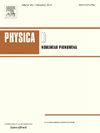New frameworks of PFM for thermal fracturing in the linear thermoelasticity solids based on a microforce balance approach
IF 2.7
3区 数学
Q1 MATHEMATICS, APPLIED
引用次数: 0
Abstract
Crack propagation due to thermal expansion is one of the multi-physics problems which be a concern to many researchers. Therefore, we study thermal fracturing using the phase field model (or, PFM). Here, the new models to study thermal fracturing in linear thermoelasticity solids are proposed through PFM. Herein, the damage evolution equation is directly derived through the microforce balance approach or the Gurtin concept, while the heat evolution equation is derived through the first principle of thermodynamics. Furthermore, the thermodynamic consistency of the model is shown by Clausius–Duhem inequality. In particular, the Gurtin concept and the first principle of thermodynamics follow the entropy, internal energy, Helmholtz free energy, and energy dissipation functions which are based on the Biot of thermoelasticity model and the Ambrosio–Tortorelli regularization. Since our models are based on the microforce balance approach, we also derive the PFM for crack propagation which was proposed by Kimura and Takaishi via this approach. In the present study, we validate our proposed PFMs through several numerical experiments. Herein, we solve the numerical experiments using the adaptive finite element method. From these, good agreements are achieved between our models and the previous model.
求助全文
约1分钟内获得全文
求助全文
来源期刊

Physica D: Nonlinear Phenomena
物理-物理:数学物理
CiteScore
7.30
自引率
7.50%
发文量
213
审稿时长
65 days
期刊介绍:
Physica D (Nonlinear Phenomena) publishes research and review articles reporting on experimental and theoretical works, techniques and ideas that advance the understanding of nonlinear phenomena. Topics encompass wave motion in physical, chemical and biological systems; physical or biological phenomena governed by nonlinear field equations, including hydrodynamics and turbulence; pattern formation and cooperative phenomena; instability, bifurcations, chaos, and space-time disorder; integrable/Hamiltonian systems; asymptotic analysis and, more generally, mathematical methods for nonlinear systems.
 求助内容:
求助内容: 应助结果提醒方式:
应助结果提醒方式:


